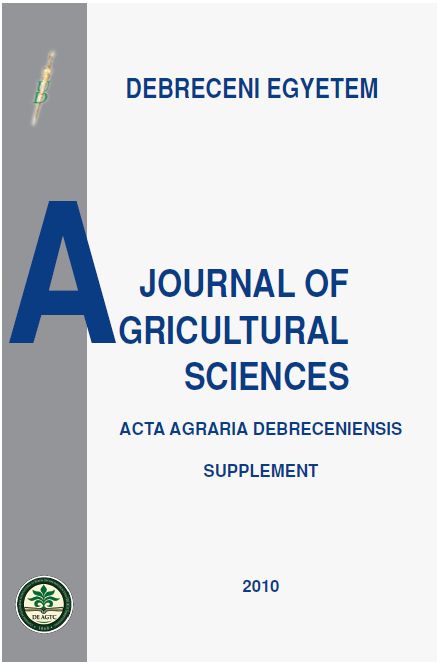The effect of agrotechnological factors and the cropping season on sweetcorn (Zea Mays L. convar. saccharata Koern.) production in a humid year
Author
View
Keywords
License

This work is licensed under a Creative Commons Attribution 4.0 International License.
How To Cite
Abstract
We have examined the effect of three agrotechnological factors (sowing time, fertilization, crop density) and four genotypes on the yield
of sweetcorn on chernozem soil in the Hajdúság region in 2009. The experiment was set up at the Látókép Research Site of the University of
Debrecen. We have included two sowing times (27 April, 26 May), six nutrition levels (control, N30+PK, N60+PK, N90+PK, N120+PK,
N150+PK) and four genotypes (Jumbo, Enterprise, Prelude, Box-R) at two crop density levels (45 thousand ha-1).
In the humid cropyear of 2010 the amount of precipitation exceeded the 30-year average by 184 mm in the cropping season; the average
temperature exceeded the same by 0.8 C on the average of the examined months. The circumstances were most favourable for sweetcorn
production with the first sowing time, thus, this was when the yield of all hybrids was the highest.
With early sowing time, the highest yield (23437 kg ha-1 yield) was obtained with Enterprise at 45 thousand ha-1 crop density level at
N150 + PK nutrition level. The highest yield of the other three hybrids was 22253 kg ha-1 (Jumbo) 22286 kg ha-1 (Box-R) and 1873 kg ha-1
(Prelude). With the second sowing time, the highest yield was obtained with Enterprise again (22237 kg ha-1) at 65 thousand ha-1 crop
density level. With this sowing time the yield of Jumbo, Box-R and Prelude was 20888 kg ha-1, 17796 kg ha-1 and 17401 kg ha-1, respectively.
We found that the highest yield was obtained at the highest nutrition levels (N120 + PK, N150 +PK) with the first sowing time, while the same
was obtained at lower nutrition levels (N90 + PK, N120 + PK) with the second sowing time.

 https://doi.org/10.34101/ACTAAGRAR/I/8393
https://doi.org/10.34101/ACTAAGRAR/I/8393